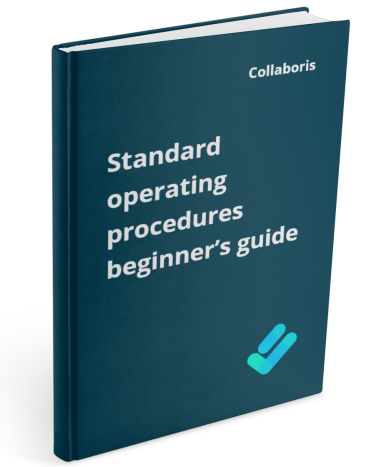Policy Approval Workflow Automated policy approval workflows offer several benefits that can significantly enhance ...
Common problems organizations have with SOP's (and their solutions)
Standard Operating Procedures (SOPs) are essential for any organization that wants to achieve consistency and efficiency in its operations. SOPs are documents that outline the steps required to complete a task or process. They also serve as a reference for employees to ensure that they follow the correct procedures.
The consequences of not following SOP's can vary from decreased work quality, inefficiency, financial losses or reputational damage. Additionally serious legal repercussions can be encountered.
However, many organizations struggle with implementing SOPs effectively. In this blog post, we will discuss the common problems organizations have with implementing SOPs and how to overcome them.
Lack of Clarity and Communication
One of the most common problems organizations have with implementing SOPs is the lack of clarity and communication. SOPs must be clear, concise, and easy to understand. If the language used is too technical or difficult to comprehend, employees may not follow the procedures correctly, leading to errors and inefficiencies. Additionally, SOPs must be communicated effectively to all employees to ensure that they understand the procedures and their importance.
Solution
To overcome this problem, organizations should involve employees in the creation of SOPs. Employees who are familiar with the process or task can provide valuable insights into the steps required and the best practices to follow. Additionally, organizations should ensure that SOPs are communicated effectively to all employees through training sessions and regular updates.
Lack of Enforcement
Another common problem with implementing SOPs is the lack of enforcement. Employees may be aware of the procedures, but they may not follow them if there are no consequences for non-compliance. This can lead to inconsistencies in the way tasks are completed and can affect the quality of the organization's products or services.
Solution
Organizations must establish a culture of accountability. This can be achieved by setting clear expectations for employees and holding them responsible for following SOPs. Additionally, organizations can implement a system of checks and balances to ensure that procedures are being followed correctly.
Get your free Standard Operating Procedures guide
Creating Standard Operating Procedures for your organisation doesn't have to be complicated. This guide will introduce you to the whole lifecycle from creation to training and distribution.
Lack of Flexibility
While SOPs are designed to provide consistency and efficiency, they must also be flexible enough to accommodate changes in the process or task. Organizations that have rigid SOPs may find it difficult to adapt to changing circumstances, leading to inefficiencies and errors.
Solution
Organizations should regularly review and update their SOPs. This can be done by soliciting feedback from employees or by conducting audits of the process to identify areas for improvement. Additionally, organizations should encourage employees to suggest changes to the SOPs to ensure that they are relevant and effective.
Lack of Integration
Another common problem with implementing SOPs is the lack of integration with other systems and processes. If SOPs are not integrated with other systems and processes, employees may find it difficult to follow the procedures correctly, leading to inefficiencies and errors.
Solution
To overcome this problem, organizations should ensure that their SOPs are integrated with other systems and processes. For example, if the SOPs require the use of specific software, the organization should ensure that the software is available to all employees and that they are trained on how to use it effectively.
Conclusion
Implementing SOPs can be challenging, but it is essential for any organization that wants to achieve consistency and efficiency in its operations. To overcome the common problems with implementing SOPs, organizations should ensure that their SOPs are clear, communicated effectively, enforced, flexible, integrated with other systems and processes, and regularly reviewed and updated. By doing so, organizations can ensure that their employees follow the correct procedures and have a positive impact on business opportunities.
We have been developing policy compliance solutions for SharePoint for over 12 years.
We understand how organizations struggle to ensure all employees have acknowledged critical documents like policies or procedures.
That's why we created DocRead, a tool that allows you to distribute policies, procedures, and important documents to employees and track acknowledgments, ensuring employee compliance and accountability.
All without leaving SharePoint.
Want to see how we can save you time and automate your employee compliance?
DocRead has enabled us to see a massive efficiency improvement... we are now saving 2 to 3 weeks per policy on administration alone.
Nick Ferguson
Peregrine Pharmaceuticals
Feedback for the on-premises version of DocRead.
Benefits you can expect
Ensure compliance and accountability
Set recurring assignments to ensure critical policies are read and acknowledged at regular intervals
Track progress and completion
The DocRead Compliance Cockpit summarizes the reading statuses of all assignments across the organization so Compliance Administrators can quickly get the complete picture
Fully integrated with SharePoint
DocRead seamlessly integrates with SharePoint content, without changing your documents or metadata
You may also like:
January 17, 2025
January 7, 2025
Creating policy review reminders in Office 365 You might want to set up a ...
December 19, 2024
Podcast: Implementing effective healthcare procedures Implementing effective healthcare procedures is an ongoing process. It ...
December 19, 2024
Podcast: 10 Powerful Strategies for Employee ComplianceOrganizations face challenges in ensuring employee compliance with ...
December 8, 2024
AI Warns About Itself: How I Asked AI to Create a Podcast on the ...
November 4, 2024
Benefits of writing SOP's In any organization, standard operating procedures (SOPs) are critical to ...


